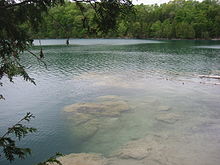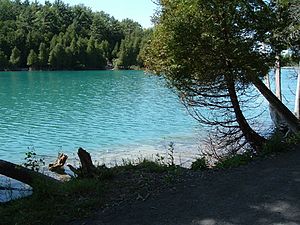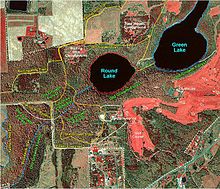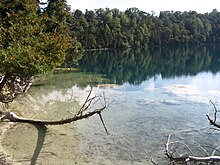Green Lakes State Park
|
Green Lakes State Park
|
||
|
View of Green Lake from the east bank. The unusual green color is caused by |
||
| location | Manlius , Onondaga County , New York , United States | |
| surface | 791 ha | |
| Geographical location | 43 ° 3 ' N , 75 ° 58' W | |
|
|
||
| Setup date | 1928 | |
| administration | National Park Service | |
Green Lakes State Park is a state park in the US state of New York east of Syracuse in the area of the Town of Manlius parish . The park is particularly picturesque and also has a masterpiece golf course designed by Robert Trent Jones at the beginning of his career. The Green Lake is probably the best-studied meromictic lake in the world - a lake in which the water layers do not mix. Also located in the park the largest inventories of primary forest (old growth forest) in Central New York and Round Lake was from the United States Department of the Interior for National Natural Landmark explained.
The core of the park is formed by two lakes, Green Lake and Round Lake, which are characterized by their unusual blue-green color. These lakes lie at the bottom of a canyon that stretches for just under a mile. The lakes and canyon are holdovers from the Ice Age and a good example of the unusual geology in this part of the state.
geography
The park area covers 1955 acres (7.91 km²); around 800,000 visitors come every year. Almost half of the park area is made up of primary forest and there are impressive examples of the tulip tree ( Liriodendron tulipifera , tuliptree), sugar maple ( Acer saccharum , sugar maple), American beech (Fagus grandifolia, beech), American linden (Tilia americana, basswood) ), Hemlock (tsuga) and occidental arborvitae ( Thuja occidentalis , white cedar). A particularly impressive grove southwest of Round Lake is known as the Tuliptree Cathedral .

Green Lake has a surface area of 65 acres (26.3 hectares) and a depth of up to 195 feet (59.4 m). The Round Lake has an area of 34 acres (13.75 hectares) and a depth of up to 170 feet (51.8 m).
Formation of canyons and lakes
The cliffs surrounding Round Lake rise to 150 ft ( 45 m ), but the canyon is actually much deeper than that. The Round Lake floor is over 50 m deep and the bottom sediments may be another 45 m thick . So a canal with a depth of approx. 120 m must have been cut out of the bedrock.
The deep gorge must have been created by a gigantic river towards the end of the last ice age around 15,000 years ago. The river consisted of meltwater from the retreating ice sheet and ran east through this channel on its way into the sea. The Niagara River Gorge below Niagara Falls is a surviving example of this landscape formation. However, it is only approx. 100 m deep and therefore somewhat shallower than the original Green Lakes gorge. Other similar canyons are in the Clark Reservation , at Smoky Hollow (1.6 km south of the Clark Reservation) and at Pumpkin Hollow (16 km west of the Clark Reservation). Geologists refer to these ravines and valleys as "the Syracuse channels".
Green Lake and Round Lake may be called "plunge pools" ( stilling basin originated) from enormous waterfalls during the ice age. However, it cannot be explained why two separate lakes were created. As you would expect from stilling pools, the lakes are quite deep in relation to their surroundings. Round Lake is approx. 60 m deep with a diameter of approx. 230 m.
Colours
About half of the water that feeds the lake comes directly from the bedrock in which the lakes are embedded. This water contains a high percentage of dissolved minerals that are not found in rainwater and surface water. The high concentration of sulfur in the deep water layers was recognized as early as 1849; in addition, the lake water also has a high concentration of calcium and magnesium . This mineral concentration leads annually to "Whiting" events in which calcite crystals and other minerals are precipitated in the water. At these times of the year the color of the lake appears emerald green and the crystals are deposited in characteristic layers. The easily recognizable “reef” along the shore at Deadman's Point in Green Lake was created over the course of thousands of years. Deadman's Point also has some extremely rare aquatic mosses and freshwater sponges.
Climate history
Usually the water layers in lakes mix at least once a year. Due to the chemical composition and physical conditions, this is not done at Green Lake and Round Lake. In the water below approx. 18 m there is a layer that does not mix with the surface water and this water layer is almost completely without oxygen, but rich in calcium, magnesium and sulfur and at the bottom of the lakes there is a clear seasonal layering of sediments deposited ( warve ), which can be read in a similar way to a dendrochronology . These varves are used to study the climate in the New York area over thousands of years.
Camping and leisure activities
Green Lake is one of the most popular swimming beaches in Central New York. At its northern end, the lake has a sandy beach, lawns and a building with changing rooms. There is a boathouse on the beach with canoe and paddle boat rentals in summer. There are also courses for stand up paddling , excursions and yoga offers. The park also has an 18-hole golf course with a clubhouse designed by Robert Trent Jones . Above the western cliff on Green Lake there is a Frisbee golf course, 137 campsites and eight wooden cabins for overnight guests. There are several picnic areas spread across the park area.
There is also a well-developed network of hiking trails, including 10 mi (16 km) cross-country ski trails . Some of the trails are also approved for mountain bikers. There are buildings mainly at the north end of the protected area. The western shore of Green Lake has no structures and Round Lake is completely natural. Mary Notarthomas wrote about this area: “When you hike on the lake paths you are in a cradle between the rich, vibrant, almost extraterrestrial blue-green waters on one side and the densely overgrown, steep forest slopes on the other. “The North Lake Trail and Round Lake Trail trails together form a 3.25 mi (5.23 km) loop.
The park is also connected to the Old Erie Canal State Historic Park , which connects to the northern end of Green Lakes State Park, via bike paths to the west . The Erie Canal , (closed in 1918), is still recognizable in this State Historic Park, and the old towpath is now a walking and biking trail. This park extends over 36 mi (57.93 km) to the Erie Canal Village near Rome .
Golf course
The Green Lakes State Park Golf Course was designed by Robert Trent Jones in 1935. This course was one of the earliest by Trent Jones, who designed around 500 courses in total. Instead of being paid, he was given a $ 1.00 / year lease. Jones opened the course on May 6, 1936, and invited Gene Sarazen to play an inaugural competition with Emmett Kelly , the first professional golfer. More than 1,000 people came to see this game.
James Dodson writes about the golf course that “the little work of art at Green Lakes, where Wendy and I and sometimes the other Taufeger stole us away to continue the game in the beautiful, mature evergreens and the long view over a dark blue ice age lake to the foothills Enjoying the Adirondacks itself remained my favorite Trent Jones golf course of all. ”Trent Jones attended the 50th anniversary of the opening in 1986.
History and planning
Efforts to acquire the land around Green Lakes to establish a state park began around 1924. Betsy Knapp described the story in her memoirs. Knapp, a descendant of the family who had farmed this area since the beginning of the 19th century, pointed out the special role played by Harry Francis , who was then a professor at the New York State College of Forestry at Syracuse University (today: State University of New York College of Environmental Science and Forestry ).
In October 1927, 725 acres were purchased for parkland. In 1929 the administration building was built according to plans by Laurie D. Cox , a prominent landscape architect (and Hall of Fame lacrosse trainer), who had designed several New York State Parks. The park's first superintendent, Arvin Henry Almquist , lived in the building for four years. The building was reopened in 2008 after being nailed up for a long time.
During the Great Depression (1929-1939), the New York State Department of Conservation (headed by then Governor Franklin Delano Roosevelt ) employed workers and later the Civilian Conservation Corps (CCC) to lay out roads, buildings, log cabins, the golf course, and trails . The CCC Camps for project SP-12 were set up on the grounds of the park. CCC company 1203 and later 2211 (a company of veterans of the Spanish-American War of 1898) were assigned to the project. These men hauled large amounts of sand from Sylvan Beach (on nearby Oneida Lake ) to create a sandy beach and hand-dug the foundations for the park's buildings. The CCC built barracks, dining rooms and other buildings for their own use. These buildings were closed in 1941. An alumni meeting of the CCC companies of Central New York was held in Green Lakes in 1988.
The CCC camp was reactivated again in 1944 during World War II to accommodate farm workers from Newfoundland for wartime. In 1945 it became the Fayetteville Camp for German prisoners of war. Fayetteville Camp was a branch of Pine Camp (today: Fort Drum near Watertown ). The camp was then closed again in 1946 when the prisoners were repatriated.
Since the first land purchase in 1928, the park area has grown by 1955 acres (791 ha). There were additional land purchases in 1960, 1975, 1995, and 1996. Plans to acquire an additional 1,000 acres appear to have remained fruitless. An additional 261 acres were acquired in 2019.
In 2008 the bathing house at the swimming area and the beach were demolished and a new building was erected at a cost of around $ 2.3 million. The building has changing facilities, toilets and showers, a snack bar and an event room.
2011 Master Plan, Environmental Impact Statement
On March 23, 2011, the State's Office of Parks, Recreation and Historic Preservation published a "Final Master Plan / Final Environmental Impact Statement for Green Lakes State Park".
This plan provides
- 1002 acres in the western half of the park are designated as a Bird Conservation Area .
- Approx. 105 acres in the jungle area (Old Growth Area) in the National Natural Landmark and the area around Round Lake is called Park Preservation Area reported
- The Rolling Hills Campground is to be expanded in the short term; in the long term, the campsite is to be relocated to an area south of the Park Office.
While the large white-tailed deer population is a problem, bow and arrow hunting remains prohibited.
See also
Individual evidence
- ^ Geographic Names Information System . United States Geological Survey.
- ↑ James Dodson: The Dewsweepers: Seasons of Golf and Friendship. Dutton Adult 2001: 181. ISBN 0-525-94582-2
- ↑ a b Martin F. Hilfiger, Henry T. Mullins, Adam Burnett, Matthew E. Kirby: A 2,500 year sediment record from Fayetteville Green Lake, New York: evidence for anthropogenic impacts and historic isotope shift. In: Journal of Paleolimnology , Vol. 26: 293-305.
- ^ A b Green Lakes State Park: Old Growth Survey . The Earth Renewal and Restoration Alliance (TERRA). Archived from the original on September 27, 2007.
- ^ "Round Lake" entry in the Registry of National Natural Landmarks. National Park Service website. December 11, 2006.
- ^ Green Lakes State Park . In: championtrees.org . Archived from the original on September 27, 2007.
- ↑ a b Green Lake Trail and Round Lake Trail Loop in Green Lakes State Park . hikespeak. Retrieved March 22, 2017.
- ^ A b c Martin F. Hilfinger, Henry T. Mullins: Geology, Limnology, and Paleoclimatology of Green Lakes State Park, New York. In: Todd W. Rayne, David G. Bailey, Barbara J. Tewksbury: Field Trip Guide for the 69th Meeting of the New York State Geological Association. New York State Geological Association 1997. ISSN 1061-8724 PDF
- ^ Bradford B. Van Diver: Upstate New York: Geology Field Guide . Kendall / Hunt Publishing Company, Dubuque 1980, ISBN 0-8403-2214-3 .
- ^ RW Allmendinger: Syracuse Channels . 2005. Archived from the original on June 7, 2013.
- ^ RW Allmendinger: Finger Lakes from the Northeast . 2005. Archived from the original on June 7, 2013.
- ↑ T. Takahashi, w. Broecker, Li YH, D. Thurber: Chemical and isotopic balances for a meromictic lake. In: Limnology and Oceanology. 1968, 13: pp. 272-292 (see also Hilfinger and Mullins).
- ↑ JB Thompson, S. Schultze-Lam, TJ Beveridge, DJ Des Marais: Whiting events: Biogenic origin due to the photosynthetic activity of cyanobacterial picoplankton. In: Limnology and Oceanography. 1997, 42, 1: pp. 133-141.
- ^ "When walking on the lake trails, one is cradled between the rich, vibrant, almost alien blue-green waters on one side and thickly vegetated, steep wooded inclines on the other." Mary Notarthomas: Green Lakes on the Allegheny Plateau . In: Travel Talk Radio Network . 2006. Archived from the original on September 29, 2007.
- ^ Geoffrey S. Cornish, Ronald E. Whitten: Robert Trent Jones (1906-2000) . In: The Architects of Golf . Harper-Collins, 1993, ISBN 0-06-270082-0 . Archived from the original on August 13, 2007.
- ↑ Chris Wagner: The Course of History: Green Lakes golf celebrates 75th anniversary. In: Syracuse Post Standard. May 5, 2011: B-1 The article also links a video interview with Rocky Kelly, the long-time main player on the course.
- ^ A b c Warren R. Petty: Green Lake State Park . In: People and Places: Fayetteville, Manlius, Minoa and Neighbors Volume II . Manlius Historical Society, 1991, ISBN 1-55787-090-X , pp. 127-144, OCLC 16228076 .
- ↑ "the original little masterpiece at Green Lakes, where Wendy and I and sometimes the other Dewsweepers slipped away to chase the game among the gloriously mature evergreens and admire the long view over a dark blue glacial lake, to the very foothills of the Adirondacks themselves , remained just about my favorite Trent Jones golf course of all. "Dodson.
- ↑ Betsy Knapp: Rocks, Fields And Beauty Forever: One Family's Memories of Fayetteville's Green Lakes 1989, OCLC 31067634 . .
- ^ New York's Heartland: The development of the state parks program in central New York 1925–1950. In: The Preservationist. New York State Office of Parks, Recreation, and Historic Preservation, Spring – Summer 2004, vol. 8, 1: pp. 14-19.
- ^ Frank Herron: Building Green Lakes State Park: A 1929 Structure Served Several Purposes. In: Syracuse Post Standard , June 27, 2004: p. H1.
- ^ A b Robert W. Hiltbrand, Thomas B. Lyons: Final Master Plan / Final Environmental Impact Statement for Green Lakes State Park . New York State Office of Parks, Recreation and Historic Preservation. March 23, 2011. Retrieved August 17, 2011. Links to the figures and appendices are at Public Documents . New York State Office of Parks, Recreation and Historic Preservation. Retrieved August 17, 2011.
- ^ CCC Camps New York . In: CCC Legacy . 2005.
- ↑ 150 Spanish War Vets at CCC Camp Leave for Ft. Dix: Finish Many Green Lake Park Improvements in 3-year Stay. In: The Fayetteville Eagle Bulletin. | date = 14. November 1941 | page = 8
- ↑ Kathy Kirpatrick: POW Camps in New York . 2010. Archived from the original on August 19, 2011. Kirkpatrick has published her work on prisoner-of-war camps in Prisoner of War Camps Across America . GenTracer, February 23, 2013.
- ^ Information Packet for Draft Master Plan and Draft Environmental Impact Statement Public Information Meeting Green Lakes State Park . New York State Office of Parks, Recreation, and Historic Preservation. July 7, 2009. Archived from the original on June 7, 2011.
- ^ Warren R. Petty: Green Lake State Park . In: People and Places: Fayetteville, Manlius, Minoa and Neighbors Volume II . Manlius Historical Society, 1991, pp. 27-144. Petty suggests that the acquisitions were made in 1960 through expropriation of the owners Howard and Robert Cross.
- ↑ New York State Will Enlarge Green Lakes Park. In: Eagle-Bulletin and Dewitt News-Times. volume = 85-12 | issue = 4 | date = 24. January 1974. Parts of the "Amos tract" were acquired on the southwest boundary of the park and in the Round Lake catchment areas.
- ^ A b Robert L. Smith: State Buys Land as Buffer for Green Lakes. In: The Syracuse Post Standard. December 28, 1995. Ms. Betsy Knapp left a legacy for the park with 17 acres of hill country on its south flank between Signal Hill and the Golden Acres Neighborhoods of Fayetteville. The piece of land consists of land which Knapp's great-great-grandfather David Collin III cultivated from 1817 and which includes a rather rare geological window made of dolomite , the so-called Indian Oven Hill .
- ^ State Adds 278 acre to Green Lakes Park. In: Syracuse Post Standard. December 15, 1995. The State of New York paid $ 2.16M to purchase 278 acres on the west flank of William Camperlino .
- ↑ Mark Weiner: State Adds 126 acre to Green Lakes Park; Farmland is Purchased on North Side of Park. In: Syracuse Herald Journal. January 29, 1996. The State of New York acquired land along the north side of the park from the Teske family's property.
- ^ Lauren Young: Green Lakes acquires 261 acres of land. In: Eagle News Online. January 21, 2019. [1]
- ^ Maureen Nolan: Lakes Gets a New Bathhouse. In: Syracuse Post Standard. October 1, 2008.
- ↑ James T. Mulder: Hunting ban is likely to stay at Green Lakes State Park. In: Syracuse Post Standard. August 29, 2010.
Web links
- New York State Parks: Green Lakes State Park at nysparks.state.ny.us
- Green Lakes State Park Golf Course webpage contact address
- Map of Green Lakes State Park . New York State Office of Parks, Recreation, and Historic Preservation. July 7, 2009. Archived from the original on June 7, 2011.
- "The Underwater World of Green Lakes" , video of a dive trip by Dr. Mark A. Teece .
- Photographs by Matthew Conheady at Green Lakes State Park.
- CNY Heritage Digital Library , with photographs by Arvin H. Almquist , the first superintendent of Green Lakes State Park (ca. 1929–1948).








